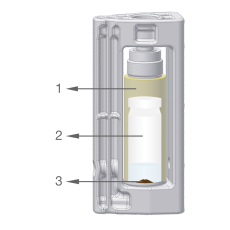

Ultratrace Inserts
Brand:
Milestone
Product Code:
Ultratrace Inserts
Availability:
In Stock
Weight:
0.00kg
Increase detection limit with lower dilution factor
Microwave digestion techniques typically require a minimum volume of reagents of about 5 mL to achieve accurate temperature monitoring of the reaction conditions and for low blank levels. However sometimes it is important to maintain an even lower dilution factor when working at concentrations near the method detection limit. These factors inspired us to use vessel-inside-vessel technology. It uses smaller secondary vessel (2) inside the primary microwave vessel (1). The secondary vessel contains sample and digestion reagents (3), while the primary vessel contains the solution in which temperature control takes place.
This setup reduces the amount of acid required for digestion, lowering dilution factor and increasing detection limit.
A variety of vessel inserts is available from Milestone in different materials (Quartz or TFM) provided in different sizes and shapes, to satisfy all application requirements.
This setup reduces the amount of acid required for digestion, lowering dilution factor and increasing detection limit.
A variety of vessel inserts is available from Milestone in different materials (Quartz or TFM) provided in different sizes and shapes, to satisfy all application requirements.
- Lower analytical blank
“To keep blank levels as low as possible the analyst must exercise care in keeping the volume of reagents to a minimum”.
T. Murphy, The role of analytical blank in accurate trace analysis.
Why maintaining a very low dilution factor
Analytical chemists are being required to measure lower and lower levels of trace metals in samples. This frequently requires the analyst to make measurements near the method detection limit which usually result in decreased accuracy and precision. Closed-vessel microwave digestion techniques require a minimum volume of 10 mL to achieve accurate temperature monitoring of the reaction conditions. Ideally, modern spectroscopic techniques require samples submitted for analysis to have acid concentration of 1 to 5% v/v. This requires samples that were digested with 10 mL of acid to be diluted by a factor of 500 to achieve the 1 to 2% acid content necessary for ICP analysis. These large dilution factors often result in some of the analytes becoming non-detectable.
These large dilutions are often overcome by maximizing the sample size relative to the amount of digestion acid. This approach works well for samples that do not contain a large amount of organic material. For samples with high organic content this is usually not an option because the reaction gases (CO2 and NOx) produced during the digestion can cause the microwave vessel to vent when larger sample sizes (greater than 0.5 grams) are used. Recent advances in understanding of microwave-assisted sample preparation have led to the development of vessel inside vessel technology as a means to improving method detection limits for high organic samples.
The Vessel inside vessel technology provides better reaction control. Controlling reaction kinetics is especially important when trying to digest large quantities (0.5 to 1.0 g) of organic material because the potential for auto-catalytic decomposition increases. Moreover, it helps control these self-sustaining auto-catalytic reactions by providing a heat sink for the energy liberated during oxidization.
These large dilutions are often overcome by maximizing the sample size relative to the amount of digestion acid. This approach works well for samples that do not contain a large amount of organic material. For samples with high organic content this is usually not an option because the reaction gases (CO2 and NOx) produced during the digestion can cause the microwave vessel to vent when larger sample sizes (greater than 0.5 grams) are used. Recent advances in understanding of microwave-assisted sample preparation have led to the development of vessel inside vessel technology as a means to improving method detection limits for high organic samples.
The Vessel inside vessel technology provides better reaction control. Controlling reaction kinetics is especially important when trying to digest large quantities (0.5 to 1.0 g) of organic material because the potential for auto-catalytic decomposition increases. Moreover, it helps control these self-sustaining auto-catalytic reactions by providing a heat sink for the energy liberated during oxidization.
© 2025 Hak Cipta Terpelihara. PT SPEKTRAKROM INDONESIA

